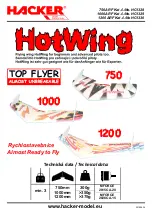
Prove
ď
te operaci na levé i pravé stran
ě
modelu.
Do operation on both sides, left and right.
Správn
ě
.
Right!
Špatn
ě
.
Bad!
P
ř
išroubovat.
Screw it.
P
ř
ilepte kontaktním lepidlem.
Glue with contact glue.
Od
ř
ízn
ě
te / pro
ř
ízn
ě
te drážku.
Cut off / Cut the slot.
P
ř
ilepte
ř
ídkým CA lepidlem.
Glue with thin CA glue.
Použijte aktivátor
lepidla ve spreji.
CA
Use CA kicker (accelerator) spray.
ø
2mm
1h
Vyvrtejte otvor o 2mm.
Drill the hole diameter 2mm.
ø
Oh
ř
ejte zapalova
č
em nebo
horkovzdušnou pistolí.
Heat up with lighter or with heat gun.
Po
č
kejte 1 hodinu.
Wait for 1 hour.
Pozor, záleží na správné orientaci dílu.
Be careful, orient correctly, use picture
for reference.
Prove
ď
te operaci na horní i spodní stran
ě
.
Do operation on both sides, top and bottom.
Obruste smirkovým papírem.
Abrade with sandpaper.
Symboly a zna
č
ky používané p
ř
i stavb
ě
/
Symbols used in building
www.hacker-model.eu
4
Nastavení výchylek kormidel /
Control surface
settings
deflection
Let
Udržujte si p
ř
ehled o pohybu ostatních model
ů
ve vzduchu. Je dobré mít
pomocníka, který provoz ostatních model
ů
sleduje a podává vám
informace. Po startu model srovnejte do vodorovného letu a vytrimujte tak,
aby let
ě
l rovn
ě
. Postupn
ě
si vyzkoušejte r
ů
zné režimy letu a manévry. Ve
v
ě
tší výšce vyzkoušejte také minimální rychlost, abyste se seznámili s
chováním modelu p
ř
i p
ř
istání. Pozor na kapacitu baterie, abyste
s
modelem stihli v
č
as p
ř
istát.
P
ř
istání
Chcete-li zahájit p
ř
iblížení na p
ř
istání, uberte plyn. Nechte nos modelu
mírn
ě
dol
ů
a pomalu snižujte výšku letu a udržujte sníženou rychlost.
Ud
ě
lejte poslední zatá
č
ku sm
ě
rem k p
ř
istávací dráze (proti v
ě
tru),
udržujte sestupovou rovinu a rychlost letu.
Postupn
ě
ubírejte plyn a mírn
ě
p
ř
itahujte elevony až se model dotkne
zem
ě
. P
ř
ed dotykem modelu se zemí vypn
ě
te motor.
Takeoff
Remember to takeoff into the wind. When you are ready, hold the model for
the wing tip and gently toss in a gentle climb up into the air. If you have a
helper he can hold the modelon the trailing edge during take off. Beware of
spinning propeller!
Flight
For reassurance and to keep an eye on other traffic, it is a good idea to
have an assistant on the flight line with you. Tell him to remind you to
throttle back once the plane gets to a comfortable altitude. Wh le full
throttle is usually desirable for takeoff, most models fly more smoothly at
reduced speeds. Take it easy with the
for the first flight, gradually
getting acquainted with it as you gain confidence. Adjust the trims to
maintain straight and level flight. After flying around for a while and while
stil at a safe altitude with plenty of battery life, practice slow flight and
execute practice landing approaches by reducing the throttle to see how
the model handles at slower speeds. Add power to see how she c imbs as
well. Continue to fly around, executing various maneuvers and making
mental notes (or having your assistant write them down) of what trim or
C.G. changes may be required to fine tune the model so it flies the way you
like. Mind your battery charge, but use this first flight to become familiar
with your model before landing.
i
l
l
HotWing
Landing
every
Remember to think.
To initiate a landing approach, lower the throttle while on the downwind leg.
Allow the nose of the model to pitch downward to gradually bleed off
altitude. Continue to lose altitude, but maintain airspeed by keeping the
nose down as you turn onto the crosswind leg. Make your final turn toward
the landing place (into the wind) keeping the nose down to maintain
airspeed and control. Level the attitude when the model touches the
ground. One final note about flying your model. Have a goal or flight plan in
mind for
flight. This can be learning a new maneuver(s), improving a
maneuver(s) you already know, or learning how the model behaves in
certain conditions (such as on high or low rates). This is not necessarily to
improve your skills
a
but more importantly so
you do not surprise yourself by impulsively attempting a maneuver and
suddenly finding that you've run out of time, altitude or airspeed. Every
maneuver should be deliberate, not impulsive. For example, if you're
going to do a loop, check your altitude, mind the wind direction
(anticipating rudder corrections that will be required to maintain heading),
remember to throttle back at the top and make certain you are on the
desired rates (high/low rates). A flight plan greatly reduces the chances of
crashing your model just because of poor planning and impulsive moves.
(though it is never bad idea ,
!)
Scheme - minimally 3 channel R/C set with power set
Schéma zapojení - minimáln
ě
3 kanálová RC souprava s pohonnou jednotkou
Kormidlo / Controlled
surface
Nastavení / Settings
EXP
EXP
ELEVONY / ELEVONS
ELEVON
HotWing 750
HotWing 1200
x = ± mm
17
y = ± mm
25
x = ±25mm
y = ±40mm
VÝCHYLKA (jako VOP) /
DEFLECTION (as a elevator)
VÝCHYLKA (jako k
ř
idélka) /
DEFLECTION (as a ailerons)
30%
30%
30%
30%
Poznámka: P
ř
esné nastavení si upravte dle vlastních zvyklostí. Pro nastavení výchylek použijte bu
ď
speciální program ve vysíla
č
i (DELTA nebo ELEVONS) p
ř
ípadn
ě
upravte výchylky pomocí D/R.
Note: Customize exact settings by your own. Use special TX program for flying wing (DELTA) or D/R.
HotWing 1000
x = ±20mm
y = ±30mm
30%
30%






























